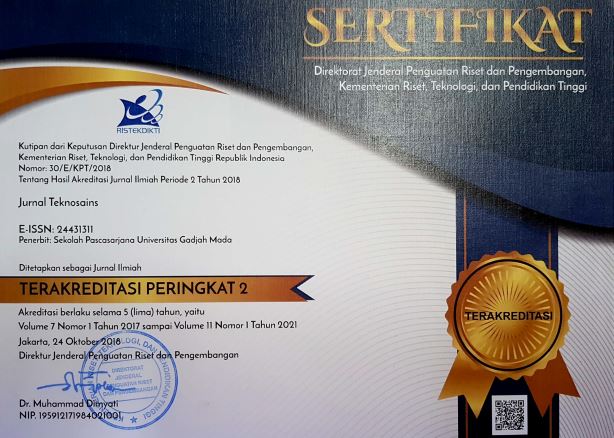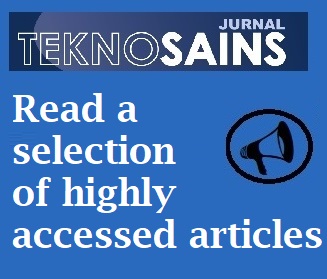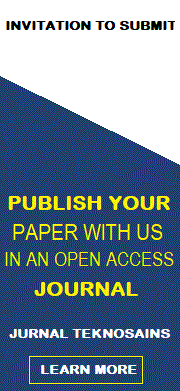Pengaruh faktor pengali asimetri terhadap kapasitas beban angkat perempuan Indonesia
Mayesti Kurnianingtias(1*), Ardiyanto Ardiyanto(2)
(1) Akademi Komunitas Industri Tekstil dan Produk Tekstil Surakarta
(2) Universitas Gadjah Mada
(*) Corresponding Author
Abstract
Manual material handling can improve occupational diseases such as low back pain and musculoskeletal disorders. In an attempt to reduce the risk of injury as a result of such work, NIOSH published the recommended weight limit (RWL) equation. The RWL formulation was made with Europeans and Americans, so this research was conducted to see the suitability of the RWL formulation for Asians, especially Indonesians. The participants of this study were 30 Indonesian women students. The independent variable in this research is the asymmetry multiplier. The participants perform asymmetric lifting in 0, 30, 60, and 90 degrees with the frequency of 1 lift/min in a 30-minute duration. Other multiplier factors such as the vertical multiplier, distance multiplier, and coupling multiplier are made to have a value of 1. The weight of the load lifted by the respondent is adjusted to the maximum load that each respondent can lift comfortably, which is usually called the maximum acceptable weight of lift (MAWL). The heart rate data used for analysis is the heart rate in the last five minutes. In addition, respondents also filled out the Borg RPE scale. The results of this study were that the heart rate increased from an average resting heart rate of 83.12 beats/minute to 90.6 beats/minute. The statistical test results showed that there was no significant effect between asymmetry lifting tasks on heart rate, energy expenditure, and the Borg's Scale RPE (α = 0,05). Energy expenditure in this study is still below the threshold set by NIOSH. From this study, the predicted AM equation of physiological for Indonesian (energy expenditure) is AM = 1 - (0,0024A) and the predicted AM equation of RPE is AM = 1 - (0,0029A).
Keywords
Full Text:
PDFReferences
Bigos, S.J., Spengler, D.M., Martin, N.A., Zeh, J., Fisher, L., dan Nachemson, A., 1986, Back Injuries in Industry : a Restropective Study, III, Employee Related Factors, Spine, 11, pg. 252-256.
Borg, G., 1982, Psychophysical Bases of Perceived Exertion, Medicine and Science in Sports and Exercise, Vol 14, No 5, pg. 377-381.
Chuan, T.K., Hartono, M., dan Kumar N., 2010, Anthropometry of the Singaporean and Indonesian Populations, International Journal of Industrial Ergonomics 40, pg. 757-766.
Dempsey, P.G., dan Fathallah, F.A., 1999, Application issues and theoretical concerns regarding the 1991 NIOSH equation asymmetry multiplier, International Journal of Industrial Ergonomics 23, pg. 181-191.
Garg, A. dan Banaag, J., 1988, Maximum Acceptable Weights, Heart Rates and RPEs for One Hour's Repetitive Asymmetric Lifting, Ergonomics, Vol. 31, No. 1, pg. 77-96.
Ghaffari, M., 2007, Low Back Pain Among Industrial Workers, Department of Public Health Karolinska Institutet, SE-171 77, Stockholm, Sweden
Grandjean, E., 1993, Fitting the Task to the Man, Taylor & Francis Inc, London.
Gross, M.T., Dailey, E.S., Dalton, M.D., Lee, A.K., McKiernan, T.L., Vernon, W.L., dan Walden, A.C., 2000, Relationship between Lifting Capacity Anthropometric Measures, Journal of Orthopaedic and Sports Physical Therapy, 30(5) : 237-247, 258-262
Kumar, S., 1984, The Physiological Cost of Three Different Methods of Lifting in Sagittal and Lateral Planes, Ergonomics, No 4, pg. 425-433.
Mital, A., dan Fard, H.F., 1986, Psychophysical and Physiological Response to Lifting Symmetrical and Asymmetrical Loads Symmetrically and Asymmetrically, Ergonomics, No. 10, pg. 1263-1272
Murphy, P.L., dan Courtney, T.K., 2000, Low Back Pain Disability : Relative Costs by Antecedent and Industry Group, American Journal of Industrial Medicine 37, 558-571.
Nurmianto, E., 1991, Faktor Untuk Iklim Ruangan dan Kenyamanan Suhu dalam Rancang Bangun Pesawat Terbang Penumpang, Proceedings Makalah Simposium Nasional Ilmu Pengetahuan dan Teknologi dalam Rekayasa Aeronautika, IPTN Bandung.
Nussbaum, M., Chaffin, D., dan Page, G, 1995, A Biomechanical Investigation Of The Asymmetric Multiplier In The Revised NIOSH Lifting Equation, Proceedings of the Human Factors and Ergonomics Society 39th Annual Meeting (pp. 709–713), Santa Monica, CA, USA: Human Factors and Ergonomics Society.
Snook, S.H., Campanelli, R.A., dan Hart, J.W., 1978, A Study of Three Preventive Approaches to Low Back Pain, Journal of Occupational Medicine 20, 478–481.
Waters, T.R., Putz-Anderson, V., dan Garg A., 1994, Application Manual for the Revised Niosh Lifting Equation, National Institute for Occupational Safety and Heath Division of Biomedical and Behavioral Science, Cincinnati, Ohio.
Wignjosoebroto, S. 2000, Ergonomi, Studi Gerak dan Waktu Teknik Analisis untuk Meningkatkan Produktivitas Kerja, Jakarta : PT. Gunawidya.
Wu, S., 2000, Psychophysically Determined Symmetric and Asymmetric Lifting Capacity of Chinese Males for One Hour's Work Shifts, International Journal of Industrial Ergonomics, 25, pg. 675-682
Wu, S., 2003, Maximum Acceptable Weights for Asymmetric Lifting of Chinese Females, Applied Ergonomics 34 pg. 215-224.
Article Metrics
Refbacks
- There are currently no refbacks.
Copyright (c) 2023 Mayesti Kurnianingtias, Ardiyanto Ardiyanto

This work is licensed under a Creative Commons Attribution-ShareAlike 4.0 International License.
Copyright © 2024 Jurnal Teknosains Submit an Article Tracking Your Submission
Editorial Policies Publishing System Copyright Notice Site Map Journal History Visitor Statistics Abstracting & Indexing









